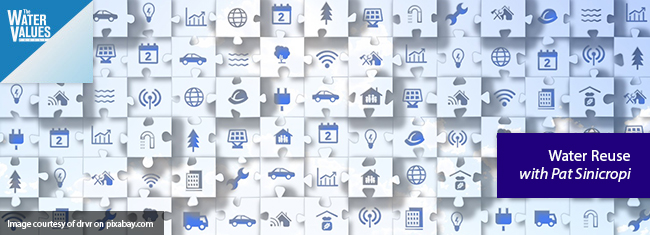Podcast: Play in new window | Download
Subscribe: Apple Podcasts | Android | RSS

Water Reuse Association (WRA) Executive Director Patricia Sinicropi joins The Water Values Podcast for a deep dive into the current state of water reuse. Pat identifies current geographic hotbeds in the U.S. for water reuse, discusses the impact of recently passed legislation, and provides her forecast for water reuse in the future.
In this session, you’ll learn about:
- The WRA’s One Water strategy
- The interesting history of the WRA
- The current geographic reach of the WRA
- The interplay between federal and state policies on water reuse
- Why most action in water reuse occurs at the state level
- How federal policy drives state action
- Recent federal legislation
- Common reuse applications
- The status of direct potable reuse
- Educational tools for water reuse
Resources and links mentioned in or relevant to this session include:
- The Water Reuse Association’s website
- Water Reuse Association’s Twitter Handle: @WateReuseAssoci
- National Academies of Sciences, Engineering & Medicine webpage explaining water reuse
- TWV #080: Water Reuse and Technological with GE Water’s (now Suez’) Jon Freedman
- TWV #125: The Current State of US Water Infrastructure Policy with Jon Freedman
Thank You!
Thanks to each of you for listening and spreading the word about The Water Values Podcast! Keep the emails coming and please rate and review The Water Values Podcast on iTunes and Stitcher if you haven’t done so already. And don’t forget to tell your friends about the podcast and whatever you do, don’t forget to join The Water Values mailing list!
Hello. A colleague recommended your website and in particular your podcasts. I’ve just listened to the interview with Pat Sinicropi which I found very interesting. I was particularly interested in the discussion on direct potable reuse and efforts to engage the medical and public health communities.
As a bit of background my company specializes in the control of waterborne pathogens in man-made water systems, helping to control the risks associated with nasty bugs like Legionella, Pseudomonas and other pathogens.
While the techniques and quality controls to create high quality potable water at a large scale municipal level are well established I’d be very interested to learn how these processes and quality standards are being tackled in smaller scale recycling plants like the mobile treatment trailers. Any more information or references would be appreciated. Many thanks
Hi Simon - below is guidance I received from a colleague who works specifically with smaller treatment systems. I hope this addresses your question:
For potable reuse, we apply the same treatment standards and water quality standards (for chemicals and pathogens) to decentralized potable reuse as we do with municipal scale potable reuse. From a pathogen point of view, we use the 12/10/10 log removals for viruses, Cryptosporidium, and Giardia to meet health goals (in this case 1 in 10,000 risk of infection from these pathogens). Because we are drinking the water, the standards have to be met for all potable reuse systems – large and small.
However, based on bringing up Legionella and Pseudomonas, the question may have more to do with managing the water in the distribution systems. The standards above address treatment standards and water quality standards in the treated effluent. The two bacteria mentioned can regrow in the distribution systems and cause issues. So, management of the distribution systems is important for drinking water and potable ruse as it is for premise plumbing. The control for these bacteria in these situations involves appropriate management and operations of these “man-made” systems.
Hi Pat. Many thanks for the additional information. My main concern in using non municipal direct potable reuse technologies in sensitive facilities (hospitals) would be that it was less effective at removing waterborne pathogens. Allowing more to enter a water system than would otherwise be expected. The risks associated with colonisation would then increase. Can you recommend any papers or websites with more detail on the technologies used? Thanks again for your time.